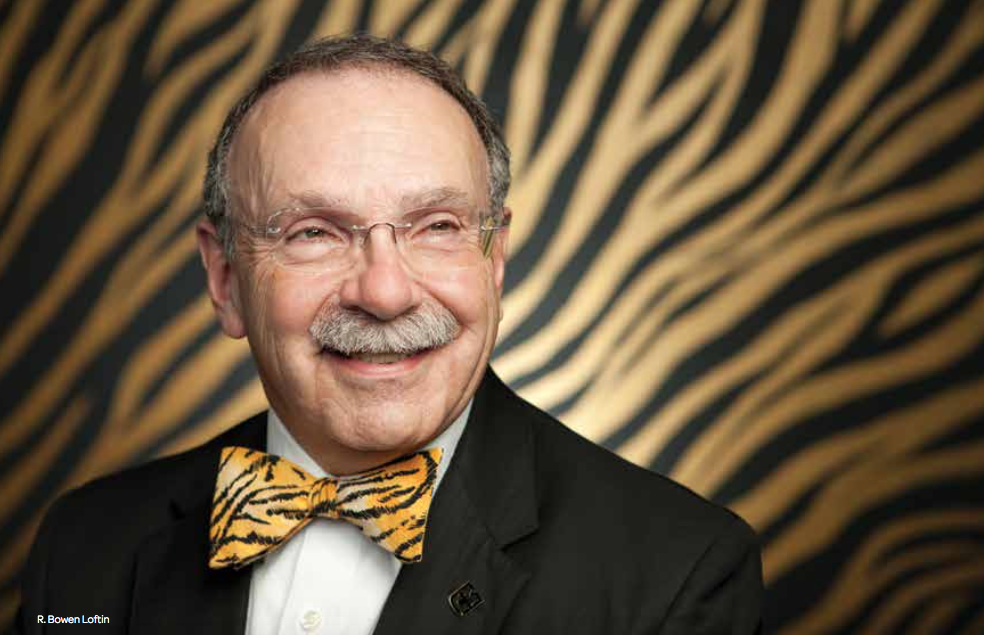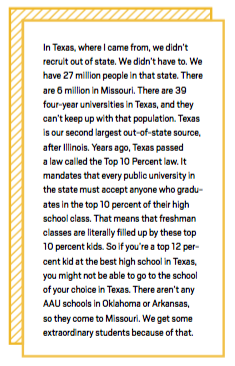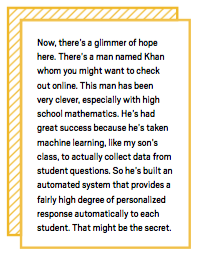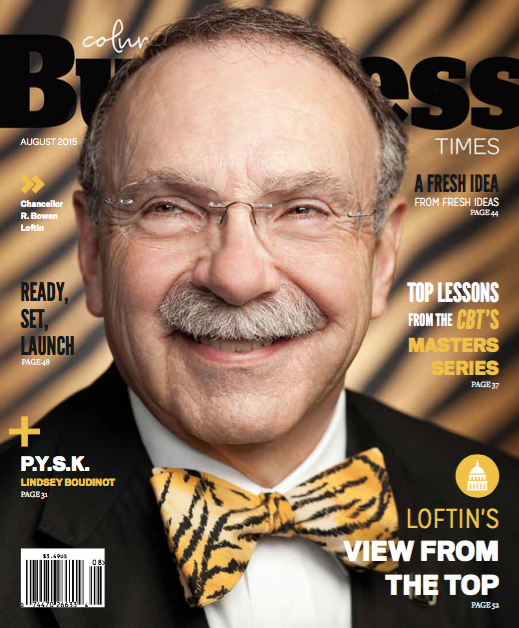Loftin’s View from the Top

CBT: What would you say has been the most significant change you’ve made since becoming chancellor?
Loftin: I think it’s the leadership team that has assembled here over the past year or so. Typically, universities don’t change very rapidly, but I came here at a time when almost all of the senior leadership had elected to retire or go someplace else, so it was a rather unusual circumstance. It was actually one of the factors of why I came because I really had the opportunity to make things happen quickly. At the end of August, there’ll be exactly three people left of the 12 who were here when I got here.
I don’t want to criticize the past at all. The issue is that a lot of these people had been here a very long time, and in my mind it’s very difficult for you to be fresh about how you view an institution when you’ve been part of it in a leadership role for 20, 25 or 30 years. This is my third institution to lead in 11 years now, and this is the best team I’ve ever had.
CBT: What are some of the most important new ideas this team has brought forward?
Loftin: There are a couple of things we did last year that were very impactful. One is that we decided to make a real effort to renew our faculty. We have three kinds of faculty: core faculty, which are the tenure earning faculty; full-time non-tenure track faculty; and some who teach some part time. We normally have about 1,200 faculty who are tenured or are earning tenure right now. Usually among those who are tenured, about 11 or 12 retire each year. Recently, we put together a voluntary separation program. We said, “We want to offer you an opportunity to leave now and not three, four, five years from now.” This year 111 are retiring, and that’s about 10 percent of our tenure earning faculty. We can make some big, big advancements quickly by having new faculty join us who bring the latest ideas and experiences from around the world to us.
CBT: How many times a day do you check Twitter?
Loftin: Normally, it’s several dozen times a day for a very short period of time. and then I spend usually about 45 minutes a night looking over the day’s timeline. To understand how I use Twitter, it’s two purposes for me. One is that it’s a direct connector to the students. during my momentary checks, I always check notifications, and if someone directs a tweet at me with a question or comment, then I will try to reply to that while I’m walking between meetings or in the elevator. I forward many to my staff when there’s an issue I can’t resolve personally, which is very common. It’s a matter of my trying to be responsive to a student, and I may get 50 of those a day.
But I also follow hundreds of students here, and I try to pick them from every class and every major. at night before I go to sleep, I’ll sit there and look at the timeline. It gives me a pulse of the university and a sense of where people are happy and sad. That’s what I act on in terms of leadership. I can actually get a sense of the campus feel on a given day. Not many leaders have that. You don’t get that opportunity typically to ask that question and get really unvarnished answers. It’s pretty raw.
That’s what I saw during Ferguson. What really struck me was the grand jury results. I was on Twitter when the decision was released. I could feel the anguish that hundreds of our students were feeling. It was palpable. and that’s when I did that first forum.
CBT: Since the incident in Ferguson last year, you’ve held three public forums. What has come from those forums?
Loftin: The decision came out during Thanksgiving weekend, so when the students got back, we had our first forum. What surprised me was that Ferguson was not the issue. It started off about Ferguson, but it really got out dozens of voices of anxiety and anguish about their own treatment here on campus. That really was quite startling to me. It was pretty impactful.
So we started a process of listening and trying to work through a series of actions that we think will help over time to make these things better. The challenge is that the expectations of a 19-year-old and the reality of making something happen are not quite the same. I think it continues to be a sore spot for many students; they don’t see actions that are immediate. But you don’t change hearts that way. This will take a sustained effort over generations of students here.
We made a website for it, transparency.missouri.edu, to direct students to see what’s happening right now. The deputy chancellor has announced his retirement, and one of his duties was to oversee the Office of Diversity. I’m taking advantage of that to rethink how we structure ourselves in terms of inclusion, equity and diversity. We’re asking our faculty to look at themselves and see if they might subconsciously do things that might be hurtful.
We are also stepping up some of the education and training efforts for the current incoming freshmen. during Summer Welcome, we have a cadre of students and parents coming through every day, and we’re using that as opportunity to help those students look differently at their responsibility to make this an inclusive campus.
CBT: You have a Ph.D. in physics. How do you see your background in science benefitting your role now?
Loftin: I don’t do much physics anymore in a direct way, but physics is very analytical, and I approach my decision-making that way. That discipline I learned long ago gives me a mechanism to really evaluate lots of data and make better informed decisions.
Secondly, I was a very active researcher for a long time. I was very successful in terms of achieving grants and publications, so I know what it takes. That’s something Mizzou has had a declining track record in for a while. One of the reasons I was asked to consider this job was the fact that I did bring a fairly active research history with me and also had worked at another AAU school. It’s important for Mizzou to have a renewal of its emphasis on discovery and creativity.
CBT: What are your goals for the expansion of the MU Life Sciences Incubator?
Loftin: The incubator is maxed out right now in the wet labs, but we also added a new piece to the incubator to focus on digital ventures as a way to support some of the software that’s going on here in terms of commercialization. Bill [Turpin] is doing his best to expand the reach of the incubator beyond the traditional life sciences to some of the software environments that can be highly successful very quickly with low overhead capital investments, compared to a big life science project involving the reactor or something like that. and Hank [Foley] is trying to raise the money to really expand the incubator and add a whole other wing to support more traditional life science programming.
CBT: There has been a lot more attention paid to entrepreneurship in general across the country and also here at Mizzou. Why the change?
Loftin: We have a lot of extraordinarily talented people here who want to be entrepreneurs. We have more than one college and school now with an entrepreneurship program. We have many different parts of the university embracing this and trying to equip their students to be entrepreneurially successful while they’re still in school. You have so much creative energy when you’re 18, 19, 20 years old. Why wait until you’re 30?
The second thing is that [students and faculty] look around and see this as an opportunity to do something that’s very American. Small businesses are what we do here in this country. Large companies get all of the headlines, but they don’t employ the most people. The future of your financial success can be predicated on your ability to have an idea and to form a small business and take it forward. If we equip you to do that, not just with your technical skills but with your business skills as well, and partner you with people who may complement you, think about the opportunity. Where else will you find the natural juxtaposition of an engineer, a life scientist and a business student? Their coming together to form a business may be the perfect combina- tion of skillsets. That just happens at a university. I believe this is our future.
 Another component of that is we are a state university. Traditionally, we had two major sources of funding: the State of Missouri and student tuition. about 20 years ago, the university got fairly busy trying to raise private money through gifts. Meanwhile, every state began to slash higher education budgets, and tuition shot up. No matter how much the state might want to help us, it will never restore its original support for this university. But even private funding isn’t going to be the answer long term for us.
Another component of that is we are a state university. Traditionally, we had two major sources of funding: the State of Missouri and student tuition. about 20 years ago, the university got fairly busy trying to raise private money through gifts. Meanwhile, every state began to slash higher education budgets, and tuition shot up. No matter how much the state might want to help us, it will never restore its original support for this university. But even private funding isn’t going to be the answer long term for us.
This university also collects between $7 million and $9 million per year in licensing fees. We are usually among the top 20 or 25 in the country among all public and privates in our licensing revenue. A license is $7,500 per year for a seed that we developed here. It takes lots of $7,500-per-year licenses to get to $7 million. That’s a very limiting factor. Where we really want to go is not protecting the intellectual property but taking this IP to externals who have capital and saying, “Let’s form a joint venture.” The investor will retain a chunk of equity, as will the university and the inventor. If that particular business is successful, it’s going to become public and could be sold. That transaction alone could be tens or hundreds of millions of dollars.
We formed a company years ago in our vet school. It’s not a product company; it’s a service company doing laboratory testing. That was sold about three years ago, and the transaction meant $40 million for the university alone. That one transaction overwhelmed three or four years of license revenue. That’s our future.
We’ve also liberalized our IP policies under [Foley’s] leadership. Now we’re trying to sell this idea as a new way of doing business with Mizzou.
CBT: Obviously, the research that’s happening here has a much wider effect on the world. What are some big success stories that Columbians should know that they might not know already?
Loftin: Our reactor here produces the majority of the world’s radioisotopes for cancer treatment. We’re still thinking about putting some type of treatment facility right next to the reactor so we could begin experimenting with the sorts of isotopes that only a reactor can create. We need to find the researchers who want to actually experiment medically with these things. We need to relocate patients very close to the reactor so you spend no more than a few minutes moving the radioisotopes from the reactor to the treatment area itself. We’re looking at ways to make that happen.
We need to find some investments from NIH, for example, or from DOE. We don’t have the funding internally to be able to put together a hospital-like facility. So we’re looking for a partner, quite frankly.
CBT: One of your goals is to a create a 25-year vision for the university. What does that vision look like?
 Loftin: We’re almost done with it right now. We went through the process late last year and early this year of establishing a steering committee that represents each of the stakeholder groups of our institution. We’re going to craft a very succinct vision from the feedback we’ve received from our stakeholders. It’s simply a vision looking forward asking, “What will Mizzou look like when it turns 200?”
Loftin: We’re almost done with it right now. We went through the process late last year and early this year of establishing a steering committee that represents each of the stakeholder groups of our institution. We’re going to craft a very succinct vision from the feedback we’ve received from our stakeholders. It’s simply a vision looking forward asking, “What will Mizzou look like when it turns 200?”
Once we get this in place, it becomes one of those things you’re going to head toward, and your plans become deliberate steps from here to there. Our planning cycle is just a few years in length. If you don’t look ahead further, your plans won’t necessarily take you where you want to go because you don’t know where you’re going.
CBT: Tell us about your first bowtie.
Loftin: I used to dress with slacks and a buttoned shirt, no tie. That was kind of the culture of my department in physics. One day, there was a written memo in everybody’s mailbox, and it said the president directed the male faculty henceforth to wear a tie. I was furious about it. I thought: “I’m going to show him. I’m going to wear a bowtie.” I didn’t even own one. I happened to have a colleague in chemistry named Jean whose husband wore bowties. So I said, “Jean, can I borrow a bowtie from Carl?” The next morning she gave me my first bowtie. It was the ugliest bowtie I’ve ever had. and I still wear it.
I have more than 400 bowties right now, and many of them are gifts. I have about 40 or 50 gold-and-black bowties, and there are about 30 or 40 I like to wear occasionally. But the ones I wear the most tend to be gifts from people who are memorable to me, and when I wear the bow- tie, I remember them.



